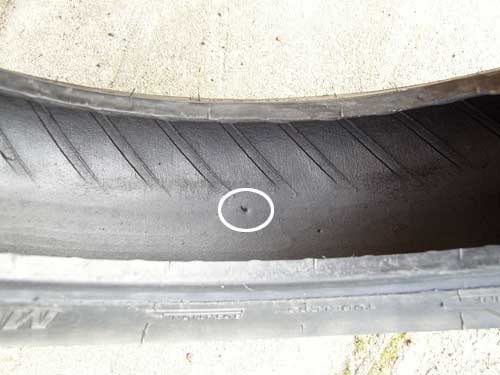Ford Mustang V6 and Mustang GT 1994-2014: How to Repair a Tire Leak
If you notice a tire leak on your Ford Mustang, don't panic. A fast and easy solution is available.
This article applies to the Ford Mustang V6 and Mustang GT (1994-2014).
Sometimes you can be driving in the city or down a highway when suddenly you'll hear a loud pop sound. If you smell burning rubber and/or see your tire pressure monitoring system (TPMS) indicator light flashing on your dashboard, you'll immediately know your tire has blown out and is in need of repair. If, however, you have a slow tire leak due to an embedded foreign object, such as sharp road debris, a nail or a piece of scrap metal, the signs of damage may appear more slowly. Here's how to fix a slow tire leak on your Mustang.

Materials Needed
- Spray bottle with dish washer liquid and water mixture
- Tire sealant
- Tire pressure gauge
- Pliers
- Tire plug repair kit
Step 1 – Check for bubbles
- Add 40 pounds per square inch (PSI) of pressure to the tire in question.
- Using a mixture of three parts water and one part dish washing liquid, spray the entire tire with the mixture.
- Be sure to wet the valve stem and all surrounding areas of the tire along the rim.
- Carefully examine the tire for signs of air bubbles.
- If you see any air bubbles, this is the location of the leak.
Step 2 – Repair tire leak
- Remove the foreign object that you located in Step 1 using a pair of pliers.
- Add several drops of sealant or rubber cement to the tip of the probe you will be inserting into the puncture hole, as directed by the manufacturer of the plug kit you've purchased for this project.
- Doing so will not only widen the hole, but also deliver the best results possible.
- Repeat two to three times.
- Next, add rubber cement to the top of the needle you will be inserting into the puncture hole to plug the open space. It's generally recommended that you apply at least two to three drops.
- Twist and turn the handle to remove the needle and finish the plugging process.
- Grab a pair of scissors and trim the excess length protruding from the puncture hole.
- Inspect the plug and follow any recommendation provided by the manufacturer.
Step 3 – Prevent future tire leaks
- Have your tires checked and balanced every time you replace your engine oil and filter, which should be at least every 3,000 miles.
- Check your tires regularly, particularly after you've just driven over roadway that is littered with sharp debris; however, only inspect your tires when it is safe and reasonable for you to do so.
- Replace any tires that have sidewall damage to minimize your risk for a blowout while driving.
- Replace your tires BEFORE the tread depth wears to below 2/32 inches.

Pro Tip
The most effective way to monitor your tire pressure is by using a tire pressure gauge.
Related Discussions and Site
- Mystery Leak in a Tire - MustangForums.com
- What Could Cause a Tire to Leak? - MustangForums.com
- Mustang Tire Leak Repair Videos - YouTube.com






